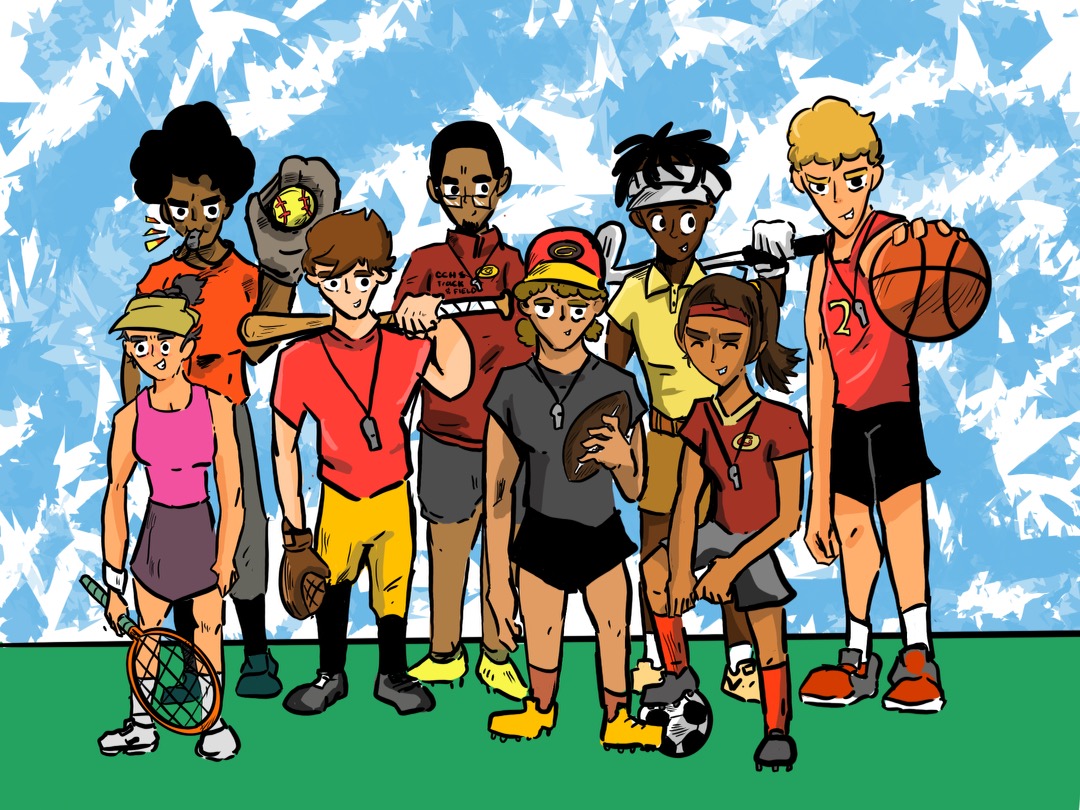Coaches of a variety of races, ages, and ethnicities are pictured. Although the sporting world has made an effort to become more diverse, these attempts focus on players rather than coaches, a disparity which is incredibly detrimental to athletes at all levels. “Diversity shouldn’t just be something that’s practiced on the field – to truly do right by the country’s athletes, minority coaches need to be given the resources to succeed just as much in the dugout as on the diamond,” Lead Copy Editor Wyatt Meyer wrote. Illustration by Sam Harwell
From the high school level all the way to the pros, every level of sports would benefit from increased coaching diversity.
Almost everyone in America knows the story of Jackie Robinson, the inspirational Los Angeles Dodgers second baseman who broke the color barrier for Major League Baseball players in 1947, but who knows the story of Frank Robinson?
Like Jackie, Frank also broke a color barrier in Major League Baseball, this time as the league’s first nonwhite manager in 1975 with the Cleveland Indians. But while students mythologize Jackie’s heroic achievement, Frank’s accomplishment – no less great – has been consigned to the margins of history.
The first major diversity issue in America’s sports world was desegregation for athletes, but today, that battle ground has shifted from the goal line to the sidelines, where diversity is still painfully lacking.
According to a 2020 article from the New York Times, every single one of five major American sports leagues – the NFL, MLB, NBA, MLS and WNBA – had at least a 15% disparity between the percentage of coaches of color versus the percentage of players of color.
This lack of diversity is just as observable in regards at the high school level – according to hiring website Zippia, only 35% of all high school coaches nationwide are non-white, while a meager 33% are women.
Diversity shouldn’t just be something that’s practiced on the field – to truly do right by the country’s athletes, minority coaches need to be given the resources to succeed just as much in the dugout as on the diamond.
It’s not as if these younger, minority coaches are any less successful – in fact, they often accomplish more than their counterparts.
Former NFL player Deion Sanders, who is Black, guided Jackson State University to unprecedented back-to-back Southwestern Atlantic Conference titles in 2021 and 2022. Assistant baseball coach Alyssa Nakken, a woman, coached with the San Francisco Giants when they won the National League West in 2021. At only 36-years-old, Sean McVay head coached the Los Angeles Rams to the 2022 Super Bowl.
Beyond that, the effects of a diverse coaching staff benefit athletes off the field.
“(Younger coaches are) more relatable and more active. They can come in and do the drills with us and show us how it’s done,” CCHS varsity basketball player Jessica Hudson, a senior, said. “Women’s sports are being advertised more, so I feel like we should have younger coaches to help us stay at the top of our game.”
Admittedly, there are some rules to encourage diversity among professional coaching staff – the NFL’s Rooney Rule stipulates that all NFL teams must interview at least one minority candidate for head coaching positions.
However, the Rooney Rule clearly isn’t carrying out all that it promises – only three out of 30 NFL head coaches are Black in a league dominated by Black athletes.
Instead of focusing on token interviews like those required by the Rooney Rule, coaching diversity needs to start at the grassroots level and be built up. Organizations like the Positive Coaching Alliance, which works to increase diversity among coaches at the youth level, need to be supported to enable them.
While not perfect, CCHS is certainly an example of a school that has empowered its coaches.
Three coaches under 40 – Head varsity flag football coach Cherelle Pass, head varsity volleyball coach Stacey Scott and head varsity soccer coach Christopher Aiken have all achieved remarkable things at their respective programs, with Pass and Scott doing so as Black females as well.
Diversity shouldn’t just be something that’s practiced on the field – to truly do right by the country’s athletes, minority coaches need to be given the resources to succeed just as much in the dugout as on the diamond.
